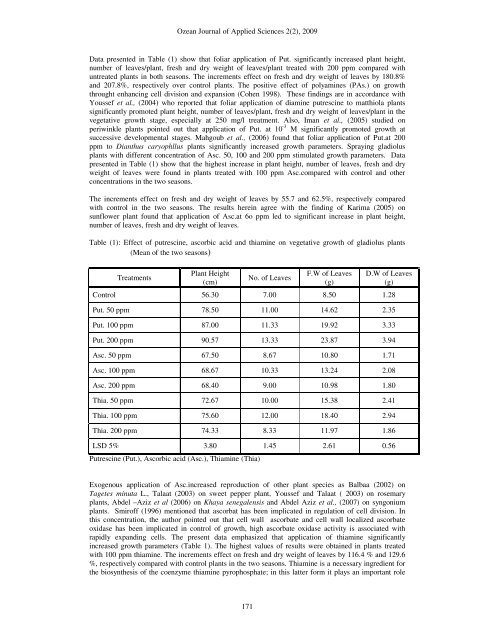Download Complate Issue - Ozean Publications
Download Complate Issue - Ozean Publications
Download Complate Issue - Ozean Publications
You also want an ePaper? Increase the reach of your titles
YUMPU automatically turns print PDFs into web optimized ePapers that Google loves.
<strong>Ozean</strong> Journal of Applied Sciences 2(2), 2009Data presented in Table (1) show that foliar application of Put. significantly increased plant height,number of leaves/plant, fresh and dry weight of leaves/plant treated with 200 ppm compared withuntreated plants in both seasons. The increments effect on fresh and dry weight of leaves by 180.8%and 207.8%, respectively over control plants. The positive effect of polyamines (PAs.) on growththrought enhancing cell division and expansion (Cohen 1998). These findings are in accordance withYoussef et al., (2004) who reported that foliar application of diamine putrescine to matthiola plantssignificantly promoted plant height, number of leaves/plant, fresh and dry weight of leaves/plant in thevegetative growth stage, especially at 250 mg/l treatment. Also, Iman et al., (2005) studied onperiwinkle plants pointed out that application of Put. at 10 -3 M significantly promoted growth atsuccessive developmental stages. Mahgoub et al., (2006) found that foliar application of Put.at 200ppm to Dianthus caryophllus plants significantly increased growth parameters. Spraying gladiolusplants with different concentration of Asc. 50, 100 and 200 ppm stimulated growth parameters. Datapresented in Table (1) show that the highest increase in plant height, number of leaves, fresh and dryweight of leaves were found in plants treated with 100 ppm Asc.compared with control and otherconcentrations in the two seasons.The increments effect on fresh and dry weight of leaves by 55.7 and 62.5%, respectively comparedwith control in the two seasons. The results herein agree with the finding of Karima (2005) onsunflower plant found that application of Asc.at 6o ppm led to significant increase in plant height,number of leaves, fresh and dry weight of leaves.Table (1): Effect of putrescine, ascorbic acid and thiamine on vegetative growth of gladiolus plants(Mean of the two seasons)TreatmentsPlant Height(cm)No. of LeavesF.W of Leaves(g)D.W of Leaves(g)Control 56.30 7.00 8.50 1.28Put. 50 ppm 78.50 11.00 14.62 2.35Put. 100 ppm 87.00 11.33 19.92 3.33Put. 200 ppm 90.57 13.33 23.87 3.94Asc. 50 ppm 67.50 8.67 10.80 1.71Asc. 100 ppm 68.67 10.33 13.24 2.08Asc. 200 ppm 68.40 9.00 10.98 1.80Thia. 50 ppm 72.67 10.00 15.38 2.41Thia. 100 ppm 75.60 12.00 18.40 2.94Thia. 200 ppm 74.33 8.33 11.97 1.86LSD 5% 3.80 1.45 2.61 0.56Putrescine (Put.), Ascorbic acid (Asc.), Thiamine (Thia)Exogenous application of Asc.increased reproduction of other plant species as Balbaa (2002) onTagetes minuta L., Talaat (2003) on sweet pepper plant, Youssef and Talaat ( 2003) on rosemaryplants, Abdel –Aziz et al (2006) on Khaya senegalensis and Abdel Aziz et al., (2007) on syngoniumplants. Smiroff (1996) mentioned that ascorbat has been implicated in regulation of cell division. Inthis concentration, the author pointed out that cell wall ascorbate and cell wall localized ascorbateoxidase has been implicated in control of growth, high ascorbate oxidase activity is associated withrapidly expanding cells. The present data emphasized that application of thiamine significantlyincreased growth parameters (Table 1). The highest values of results were obtained in plants treatedwith 100 ppm thiamine. The increments effect on fresh and dry weight of leaves by 116.4 % and 129.6%, respectively compared with control plants in the two seasons. Thiamine is a necessary ingredient forthe biosynthesis of the coenzyme thiamine pyrophosphate; in this latter form it plays an important role171
















